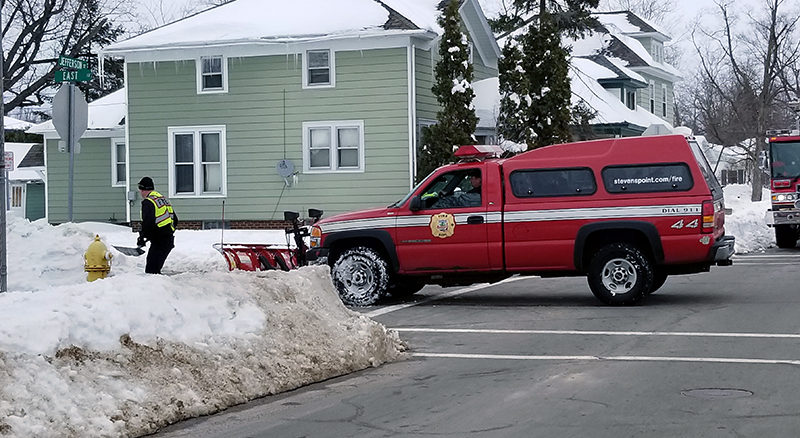Cold weather keeps firefighters busy
By Brandi Makuski
Winter weather presents additional challenges to local fire departments.
Along with the increased risk of structure fires during cold weather due to the use of internal heating systems, firefighters must also keep hydrants around the county cleared of snow, and remind residents to clear exterior home ventilation systems of snow and ice.
On top of all that, there’s the increase in water flow alarms.
The Portage Co. Communications Center has dispatched local firefighters to dozens of general fire alarm calls since the last week in January. Fortunately, the majority of those calls turned out to be a water flow alarm.
“When we get paged for a general fire alarm, it could be a working fire inside a structure or it could be some kind of problem with the sprinkler system,” said Deputy Chief Ken Voss from the Plover Fire Department. “Because we usually won’t know until we get there, our typical response is the same as if it were an actual fire.”
Plover firefighters responded to eight water flow alarms just between the last week in January and the first week of February. Two of those alarms came in simultaneously from two different sides of the same manufacturing facility on Feb. 5.
“We also had a number of other associated runs to accompany those that were based on alarm systems not properly reset, things like that,” he said.
Stevens Point firefighters responded to 14 water flow alarms during the same 10-day period—nine on Feb. 2 alone.
“When we get into these extreme temperatures that the sprinkler systems aren’t technically designed for, or prepared for, they’re going to continue to fail,” said Assistant Fire Chief JB Moody.
A polar vortex brought subzero weather to the area on Jan. 30, when a temperature of 45 below zero was recorded at the Stevens Point Municipal Airport, and the intermittent below-zero wind chill values have played havoc on local sprinkler systems—usually in commercial buildings—ever since.
“When exposed to cold temperatures, the water expands in the pipes; when the systems aren’t properly heated or installed, or insulated properly, they can have these types of failures,” Moody said. “Most systems are designed to operate above 50 degrees Fahrenheit; we’ve been well below that mark and we saw a lot of systems fail regardless of how well-maintained they were.”
Moody said water flow alarms are designed to trip the onsight fire alarm in most commercial properties. Provided it’s just a water flow problem, by the time firefighters arrive on the scene they often find thousands of gallons of water on the floor.
“Most of the time when we get a water flow alarm in the summer, it’s because a sprinkler head has been activated due to fire and we’ve got a working fire somewhere in that building,” Moody said. “But we know that usually, just the opposite is true during the winter. When we had that extreme cold, a majority of the time, it’s a fracture in the system, a pipe broke somewhere.”
Moody said firefighters know a lot of “tricks of the trade” when it comes to remediating a burst water pipe. For example, he said, if a busted sprinkler system leaves a second floor flooded, firefighters remove a toilet somewhere on that level and let the water drain through the building’s pipes.
“We kind of get used to doing that kind of thing, and since we’re already there, we try to assist as much as possible,” Moody said. “That’s part of our job, working with the property owners as best as possible to salvage and overhaul, and property conservation.”

